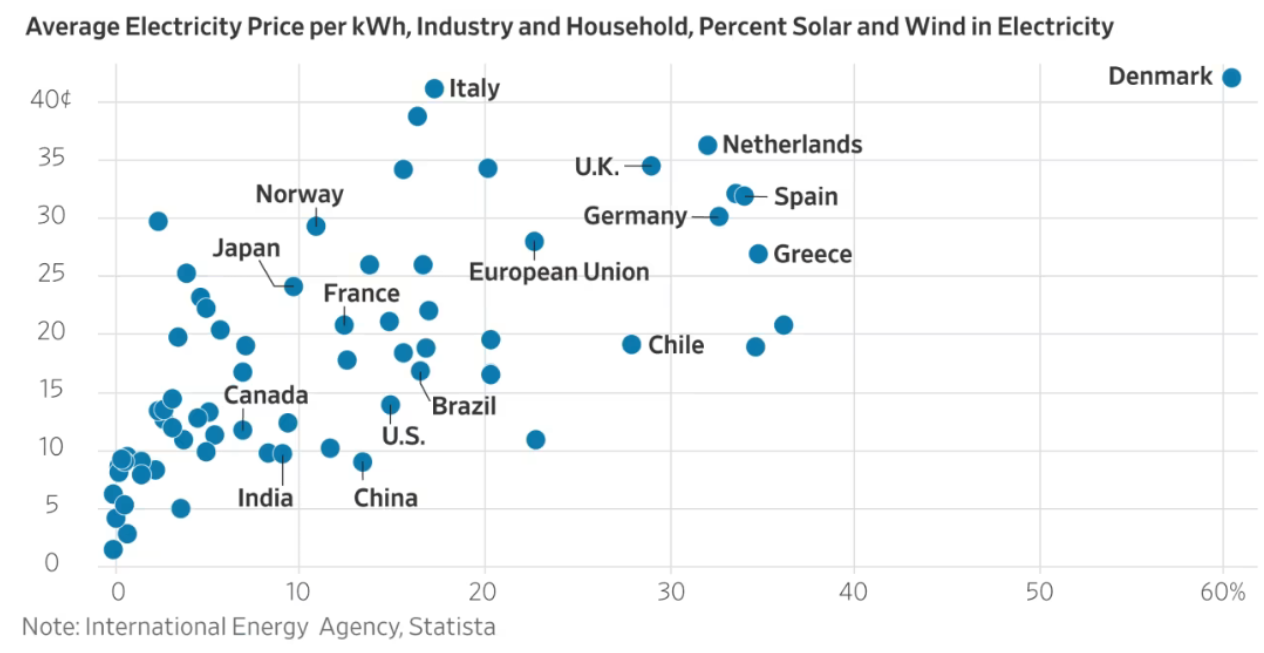Building a renewable electricity system is incredibly expensive and will inevitably increase power bills.
The global empirical evidence is clear: the higher the share of renewables in an energy system, the higher the electricity cost:

The reasons are straightforward. Renewables depend on the weather, so they are intermittent and have low load factors. They need backup generation and loads of storage. Renewables also need a lot more network infrastructure to connect the web of generation sources.
The Snowy Hydro 2.0 pumped hydro project serves as a prime example. It won’t generate any net energy; it is merely being built as a storage facility for excess solar and wind power generated during favourable weather conditions.
Snowy Hydro 2.0 will use excess renewable power generated during the day (mostly via solar) to pump water up to an elevated reservoir, which will then be released at night to generate hydro electricity when there is no solar generation.
The cost of the Snowy Hydro 2.0 project has ballooned. It was initially projected by the former Coalition government to cost about $2 billion and be completed in 2021. The government revised the cost up to $6 billion and then again to $12 billion.
Problems plague the project, which is still under construction and a long way from completion. As a result, the final cost is likely to increase further.
Underground work was halted in February 2025 after an industrial-sized ventilation fan malfunctioned, sending shrapnel flying through the air. Unions are now also threatening strike action on the project as they push for pay rises totalling more than 30% over four years.
Snowy Hydro 2.0 will also be connected via the 365km HumeLink in southwest New South Wales. This renewable project is also well behind schedule and its cost estimate has blown out to almost $5 billion.
Once again, Snowy Hydro 2.0 won’t actually produce any net electricity. It is merely a storage project for excess renewable generation (mostly solar). This project is extremely expensive. The overall cost of Snowy Hydro 2.0 and its connecting transmission lines will likely exceed $20 billion.
Snowy Hydro 2.0 is a microcosm of the gargantuan costs of the renewable transition— costs that have been largely ignored in the CSIRO GenCost report and AEMO’s Integrated System Plan.
The cost of building each of these renewable projects will increase the regulatory asset base and ultimately retail power bills.
Consumers will ultimately pay higher energy costs: either directly through their bills or via their taxes to subsidise renewables.
As UK energy expert Kathryn Porter noted in a recent podcast, “An 800 megawatt CCGT (combined-cycle gas turbine) needs one grid connection. The equivalent megawatts of wind power need 65 or more wind turbines. And that’s just to give you the nameplate. If the wind turbines are only operating a third of the time, you essentially need three times as many to produce the same amount of energy. So this leverages up very quickly”.
Porter could also have mentioned the massive costs embedded in energy storage, which is necessary to ensure that intermittent renewable supply is available to meet demand. Or the costs of keeping traditional hydrocarbon generators on standby as backup when weather conditions are unfavourable and renewable generation and storage fail.
The half a billion dollars or more of investment required for renewable generation, transmission, and storage will be paid for one way or another: either through higher retail power bills or via taxpayer subsidies.
There will be no free lunch.

